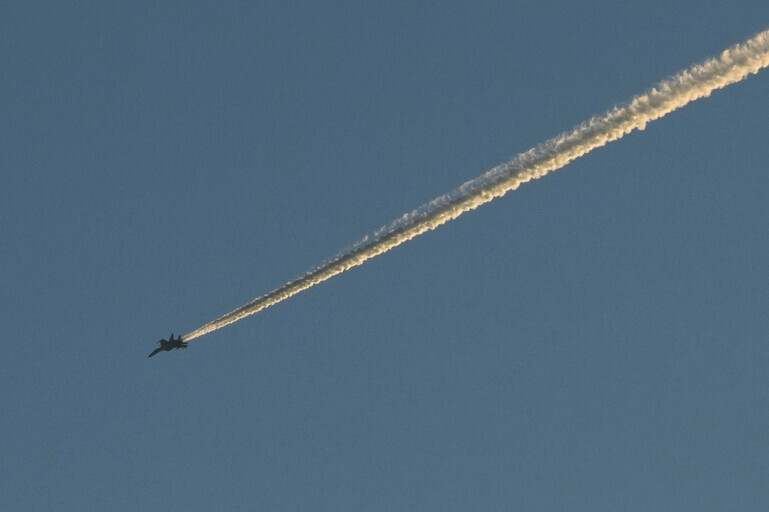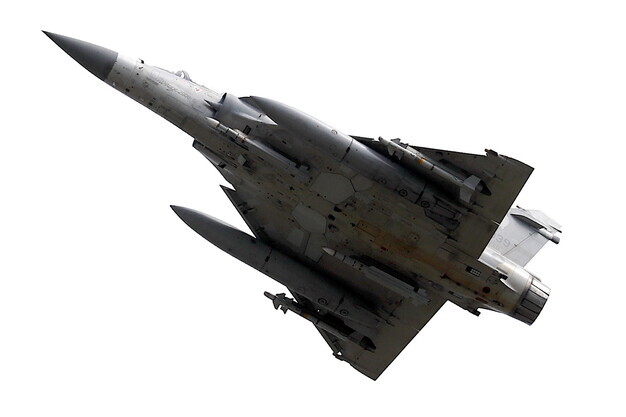hankyoreh
Links to other country sites 다른 나라 사이트 링크
Seoul’s tightrope act between US, China grows perilous as China’s drills near Korean waters

After beginning immediately following US House Speaker Nancy Pelosi’s trip to Taiwan, the military exercises by the Chinese People’s Liberation Army, which effectively encircled Taiwan for 72 hours, finally ended Sunday afternoon.
During the drills, the Chinese military blockaded the entire island of Taiwan and launched ballistic missiles that flew over Taiwan, in what amounted to a practical rehearsal for an invasion — something that would have been unimaginable even a few years ago. With China conducting military drills in the southern waters of the Yellow Sea and even in Bohai Bay, tensions around the Taiwan Strait could be felt near the Korean Peninsula as well. Military tensions on the Taiwan Strait and head-on collisions between the US and China becoming the “new normal” will inevitably have a not-so-insignificant impact on the Korean Peninsula as well.
The Chinese Maritime Safety Administration (MSA) announced on its website on Friday and Saturday that live-fire drills would be taking place for 10 days from Saturday to Aug. 15 from 9 am to 7 pm on the waters of Haizhou Bay adjoining Lianyungang, Jiangsu Province. Ships would be forbidden from entering the five sea areas of the location during this time period for safety reasons.
The Chinese MSA also revealed that a month-long military mission unrelated to the drills would take place starting Monday and running through to Sept. 8 on the waters of Bohai Bay adjoining Lushun, which is located at the tip of the Liaodong Peninsula. Although specifics of the exercise were not disclosed, it is likely to involve live-firing of ammunition, as ships were forbidden from sailing across the location during the specified time.
China is presumably carrying out the newly announced military exercises as part of its military pressure campaign on Taiwan. If China attacks Taiwan, fleets belonging to the PLA’s Northern and Southern Theater Commands as well as its Eastern Theater Command, which is adjacent to Taiwan, would be mobilized, which means these fleets would need training.
After the then-serving US secretary of health and human services, Alex Azar, visited Taiwan in August 2020, China conducted military drills one after another from Aug. 11 to late September in Bohai Bay, the Yellow Sea, the East China Sea, and the South China Sea. It would be difficult to interpret these exercises as targeting South Korea, but if the Taiwan crisis becomes normalized, the security environment surrounding the Korean Peninsula may undergo major shifts.
Discussions about “strategic flexibility” as it concerns US Forces Korea being mobilized in case of an emergency in Taiwan may begin in earnest, and demands that South Korea make military contributions like Japan’s Self-Defense Forces for the sake of peace and stability in the Taiwan Strait may surface. South Korea will not be able to remain a spectator when it comes to major changes in its security situation that the normalization of the Taiwan crisis would signify.
The Chinese military’s show of force that took place earlier was also unprecedentedly aggressive.
On Thursday, the Chinese military fired 11 Dongfeng-style ballistic missiles toward Taiwan. Four out of the 11 flew over Taiwan for the first time in history. The Taiwanese Defense Ministry reassured its public that night by stating that the missiles’ major flight course lay outside the atmosphere, so there was no danger posed to the land being flown over. All throughout its exercises, the Chinese military fired long-range artillery and conducted live-fire drills by sending warplanes and warships to the Taiwan Strait.

Dozens of Chinese warplanes flew over the Taiwan Strait every day during the exercises as well.
After Azar’s visit to Taiwan in August 2020, controversy erupted after two Chinese warplanes crossed over the median line of the Taiwan Strait — an unofficial boundary between China and Taiwan that has rarely been crossed by military planes.
On Wednesday and Thursday, however, 22 Chinese warplanes crossed the median line, while on Friday, 68 Chinese warplanes crossed the median line. This has led to the analysis that the Chinese military was training to neutralize central Taiwan, the country’s military bases, and airports with ballistic missiles on the first day, eliminate nearby fleets by mobilizing its missiles on the mainland and its navy and air force on the second day, and carry out a full-on attack of the island of Taiwan on the third day.
The Chinese Eastern Theater Command announced Saturday night that it conducted “training for striking targets land,” and the Taiwanese Defense Ministry stated through its official Twitter account on the same day that it judged China to have simulated an invasion of Taiwan.
Having been metaphorically slapped in the face by Pelosi, China has proactively used the situation to militarily pressure Taiwan and send a proper warning message to Taiwanese independence forces. Appearing on CCTV, Meng Xiangqing, a professor at the PLA National Defense University in China, argued that the drills demonstrated “that we can hit [Taiwan] whenever we want, however we want and wherever we want,” adding that they had effectively deterred “Taiwanese independence forces” and outside forces of interference. Meng pointed out that the military exercises were the closest they’d ever been to Taiwan, surrounded Taiwan from six sides, and achieved missile launches that flew through Taiwanese air.
In contrast, while conducting military exercises of its own in resistance to pressure from China on all sides, Taiwan expressed concern against intensive military training becoming the “new normal.” The Taiwanese Defense Ministry criticized China’s drills on Saturday, calling them “highly provocative.”
The US White House also released a statement in which the White House spokesperson addressed China’s military drills.
“These activities are a significant escalation in China’s efforts to change the status quo. They are provocative, irresponsible, and raise the risk of miscalculation,” the White House spokesperson said.
If military tension on the Taiwan Strait becomes the new routine, the US-Japan alliance will be strengthened in response, and demands made of South Korea will inevitably heighten.
After a meeting of the defense chiefs of the US and South Korea on July 29, the US Defense Department stated in a press release that “the two leaders also discussed a broad range of Alliance issues and exchanged views on the security environment on the Korean Peninsula and in the Indo-Pacific region” and that they “agreed on the importance of cooperating trilaterally with Japan.”
Some within the US are beginning to argue that the alliance between South Korea and the US should be recalibrated so that it can be used to respond to not just threats from North Korea but also threats from China.
There’s a possibility that South Korea, which must walk a strategic tightrope between the US and China, may be faced with a disaster-like change in circumstance.
By Choi Hyun-june, Beijing correspondent
Please direct questions or comments to [english@hani.co.kr]

Editorial・opinion
![[Editorial] Penalties for airing allegations against Korea’s first lady endanger free press [Editorial] Penalties for airing allegations against Korea’s first lady endanger free press](https://flexible.img.hani.co.kr/flexible/normal/500/300/imgdb/original/2024/0502/1817146398095106.jpg) [Editorial] Penalties for airing allegations against Korea’s first lady endanger free press
[Editorial] Penalties for airing allegations against Korea’s first lady endanger free press![[Editorial] Yoon must halt procurement of SM-3 interceptor missiles [Editorial] Yoon must halt procurement of SM-3 interceptor missiles](https://flexible.img.hani.co.kr/flexible/normal/500/300/imgdb/child/2024/0501/17145495551605_1717145495195344.jpg) [Editorial] Yoon must halt procurement of SM-3 interceptor missiles
[Editorial] Yoon must halt procurement of SM-3 interceptor missiles- [Guest essay] Maybe Korea’s rapid population decline is an opportunity, not a crisis
- [Column] Can Yoon steer diplomacy with Russia, China back on track?
- [Column] Season 2 of special prosecutor probe may be coming to Korea soon
- [Column] Park Geun-hye déjà vu in Yoon Suk-yeol
- [Editorial] New weight of N. Korea’s nuclear threats makes dialogue all the more urgent
- [Guest essay] The real reason Korea’s new right wants to dub Rhee a founding father
- [Column] ‘Choson’: Is it time we start referring to N. Korea in its own terms?
- [Editorial] Japan’s rewriting of history with Korea has gone too far
Most viewed articles
- 1In rejecting statute of limitations defense in massacre case, Korean court faces up to Vietnam War a
- 2Historic court ruling recognizes Korean state culpability for massacre in Vietnam
- 3“Those souls can rest now”: Vietnam massacre survivor reacts to Korean court win
- 41 in 3 S. Korean security experts support nuclear armament, CSIS finds
- 5[Editorial] Verdict on Korea’s massacre in Vietnam a first step in atonement
- 6Months and months of overdue wages are pushing migrant workers in Korea into debt
- 7Bills for Itaewon crush inquiry, special counsel probe into Marine’s death pass National Assembly
- 8Ruling on Korean atrocity in Vietnam comes 23 years after Hankyoreh 21’s exposé
- 9[Interview] Continuing the fight for victims of civilian massacres during Vietnam War
- 10Korea’s atrocities in Vietnam, in the words of those who saw and survived them